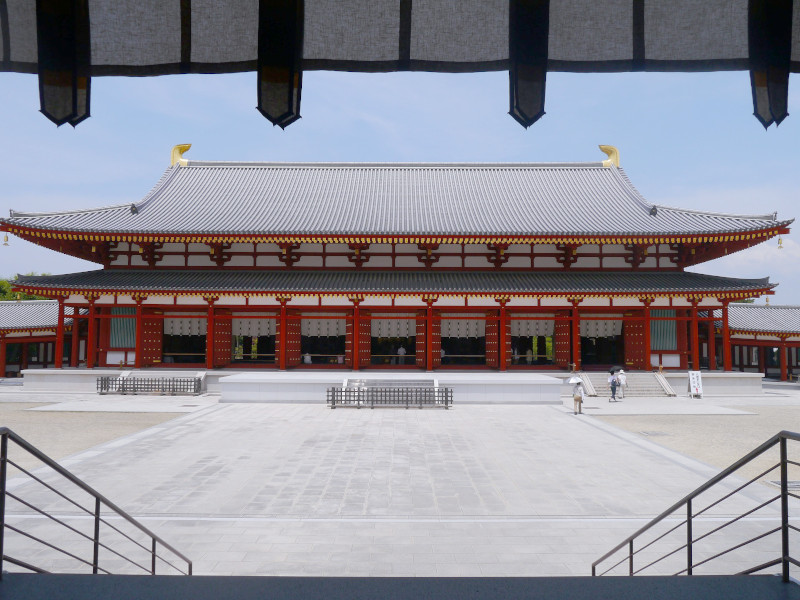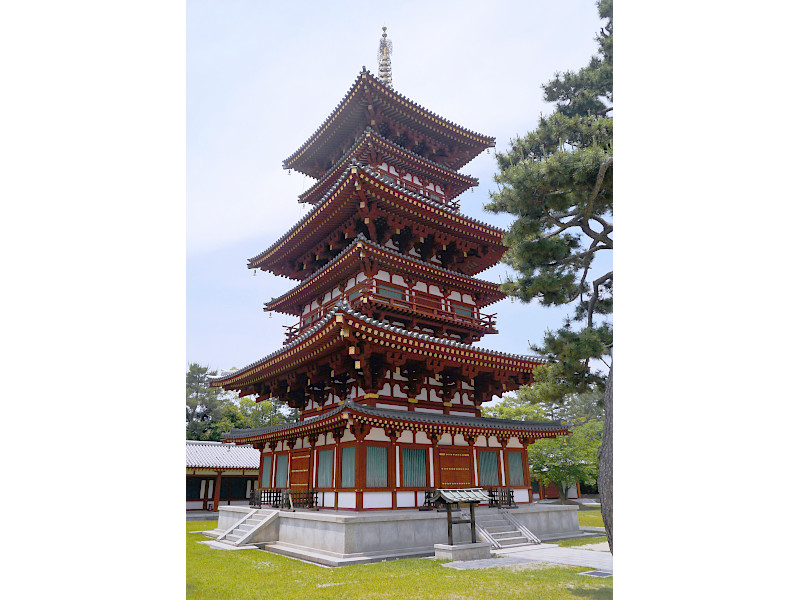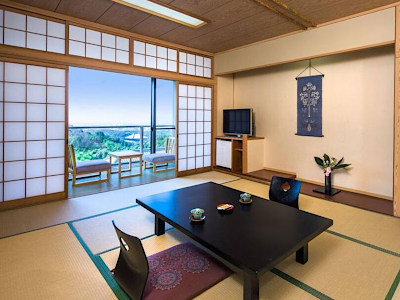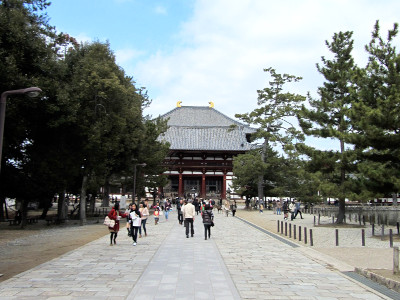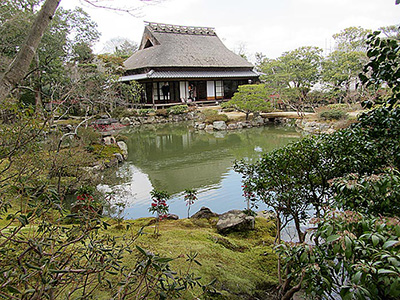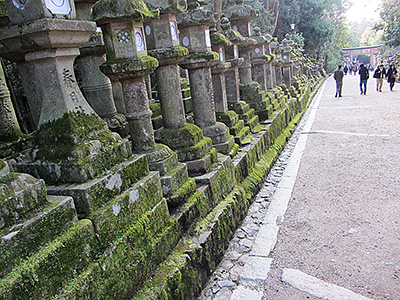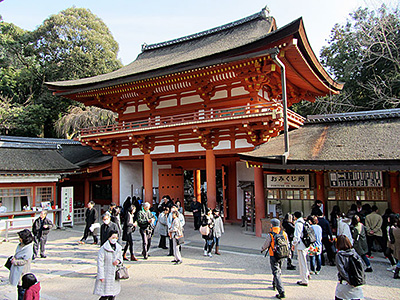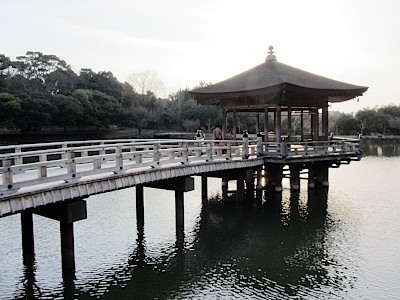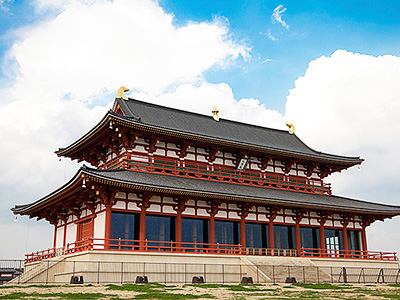Yakushiji Temple in Nara
This post can contain affiliate links, which means that we may receive a small commission if you make a purchase using these links.
Facts & Figures
The Yakushiji Temple complex is one of the Seven Great Temples of Nara (Kofukuji, Todaiji, Horyuji, Daianji, Saidaiji, Gangoji) and is dedicated to the Healing/Medicine Buddha called Yakushi Nyorai. Emperor Temmu (631 – 686) planned the whole project.
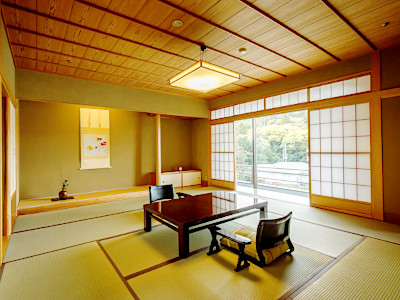 Best Places to Stay in Nara >
In 1998 the Buddhist temple was named a UNESCO World Heritage Site under the label Historic Monuments of Ancient Nara. With a history of over 1300 years, it is one of the oldest temples in Japan. The Buddhist temple is also the headquarters of the Hosso sect of Japanese Buddhism. It is the oldest Buddhist sect in the country. You will find there many important sightseeing spots and National Treasures like the West Pagoda (Saito), East Pagoda (Toto), Kondo (Main Hall, the huge Lecture Hall (Daikodo), Genjo-sanzoin Garan (Octagonal Hall), Yakushi Triad (bronze statues of Buddha, Gakko and Nikko), Hozoden (Treasury) and much more. My tip: Come here in Spring (March), when the plum trees are in full bloom.
Best Places to Stay in Nara >
In 1998 the Buddhist temple was named a UNESCO World Heritage Site under the label Historic Monuments of Ancient Nara. With a history of over 1300 years, it is one of the oldest temples in Japan. The Buddhist temple is also the headquarters of the Hosso sect of Japanese Buddhism. It is the oldest Buddhist sect in the country. You will find there many important sightseeing spots and National Treasures like the West Pagoda (Saito), East Pagoda (Toto), Kondo (Main Hall, the huge Lecture Hall (Daikodo), Genjo-sanzoin Garan (Octagonal Hall), Yakushi Triad (bronze statues of Buddha, Gakko and Nikko), Hozoden (Treasury) and much more. My tip: Come here in Spring (March), when the plum trees are in full bloom.
- Yakushiji Temple:
- Opening Hours - 8:30 am to 5:00 pm (last entry at 4:30 pm)
- Closed - open the whole year
- Admission fee - 800 yen (Adults), 500 yen (Junior/Senior high school student), 200 yen (Elementary school student)
- including Genjo-sanzoin Garan (Octagonal Hall):
- Opening Hours - 8:30 am to 5:00 pm (last entry at 4:30 pm)
- Closed - mid Jan. to end of Feb., July to mid of Sep., whole December
- Admission fee (Temple + Hall) - 1100 yen (Adults), 700 yen (Junior/Senior high school student), 300 yen (Elementary school student)
My tips for local activities
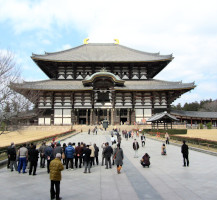
How about exploring the highlights and hidden gems of the fascinating city Nara with a local guide? The personalized tour by our partner GetYourGuide can take between 2 - 6 hours. For more details check out this page >
History
The Buddhist temple Yakushiji dates back to 680 and was originally located in Fujiwara-kyo (now Kashihara city). Emperor Tenmu (631 – 686) gave the order for the construction to pray for his sick wife and her healing process. His wife Uno-no-sarara (645 – 703) recovered in the end, but unfortunately, Emperor Tenmu died before the temple complex was finished in 698. Uno-no-sarara became after his death the Empress Jito (645 - 703). The temple was later relocated to its present location in Nara in 718, which was the new capital of Japan until 794. Yakushiji was destroyed by fire in 973 and the Kondo (Main Hall) in 1528. In 1998 Yakushiji got the status of a UNESCO World Heritage Site. There are to this day ongoing restoration projects. The last one was restoring the East Pagoda (Toto) in 2020.
Location

Yakushiji Temple is located near Heijo Palace in Nara.
Address: 457 Nishinokyocho, Nara City, Nara Prefecture, 630-8563
How to get to Yakushiji Temple?
- 1min from Kintetsu Nishinokyo Station served by Kashihara Line
Sightseeing spots
Top:
East Pagoda (Toto) - This three-story pagoda is the only remaining original wooden structure of the temple complex, which survived all the disasters in the over 1300 years of its history. The height of the pagoda is 33.6 meters supported by 17 columns. A complete restoration was finished in 2020.
West Pagoda (Saito) - The original pagoda was destroyed by a fire in 1528. Many years later in 1981, the pagoda was rebuilt in the architectural style of the Hakuho period (673 - 686). The pagoda is beautifully painted in red and green colors. Inside can be found bronze sculptures by Shinya Nakamura, which display Buddha's life and its eight great events. Shinya Nakamura unveiled his work to the public in 2015.
Kondo (Main Hall or Golden Hall) - The building houses the Yakushi Nyorai (Buddha of Healing) bronze statue. The statue with a height of 2.55 meters is framed by two 3.20 meter-high Bodhisattvas (Nikko - on the right and Gakko - on the left). These three masterpieces (Yakushi Triad) of Japanese Buddhist art have the status of National Treasures. The statues were made out of 20 tons of bronze. Empress Jito (645 - 703) sanctified the statues in 697. Pay attention to the 1.50-meter-high pedestal with its ancient motifs of the Silk Road. The hall itself was destroyed many times in the last centuries. In 1968 through donations, enough money was collected to start rebuilding the hall. The whole project was finished in 1976.
Large Lecture Hall (Daikodo) - This impressive building is with a length of 41 meters, a height of 17 meters, and a depth of 20 meters one of the largest wooden structures in Nara. It was built in 2003. Inside you will find many important statues like the Miroku Triad.
Genjo-sanzoin Garan - This Octagonal Hall was built in 1991 and is devoted to the monk Genjo Sanzo (602 - 664) from China. His remains are enshrined here. He was well-known for his travels through Central Asia and to India along the Silk Road. His lessons had a huge impact on the Hosso Sect of Japanese Buddhism.
Hirayama Ikuo (1930 - 2009) - This famous Japanese artist was known for its beautiful Silk Road paintings. An exhibition of his work can be found close to the Genjo-sanzoin Garan.
Meditation Hall or East Hall (Toindo) - It is the oldest meditation hall in Japan and dates back to 721 and was rebuilt in 1285. Inside you will find the 1.9-meter-high statue of Sho-Kannon, a national treasure, made out of platinum and bronze.
Festival & Events in Nara (dates can change without notice)
March
Omizutori Festival (1st - 14th)
This Japanese Buddhist festival dates back 1000 years. Priests at the Todaiji Temple perform rituals (called Shuni-e) for 14 days. They pray for world peace and, a rich harvest, and confess their sins. A very special event during these 14 days is Otaimatsu. Priests ran with huge pine torches through the corridors of the Nigatsu-do Hall. It is said that if you get hit by these fire sparks no evil thing will harm you. Don't miss out on the Omizutori ceremony on the 13th of March. Water is being collected by priests in front of the Todaiji Temple. It is believed this water has the power to cure diseases.
August
Toka-ye Lantern Festival (5th - 14th)
Thousands of candles are lit everywhere in Nara between 7:00 pm and 9:45 pm. Enjoy this special atmosphere in Nara Park, temples and gardens.


